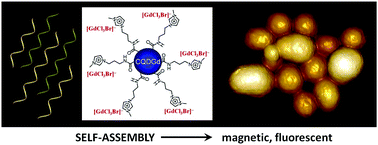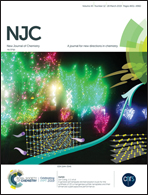Fluorescent hybrid nanospheres induced by single-stranded DNA and magnetic carbon quantum dots†
Abstract
The functional and structural properties of self-assembly materials are regulated by their building blocks with regards to structural functional motifs or the introduction of valuable responsiveness. In this work, fluorescent carbon quantum dots with magnetic [GdCl3Br]− counterions (CQDGd) were firstly synthesized, and they further served as building blocks for self-assembly with groups of single-stranded DNA (ssDNA), including phosphate, guanine and cytosine, generating regular hybrid DNA nanospheres. Through a self-assembly process involving hybrid DNA nanospheres, a conformational transition of ssDNA occurred, and this changed the fluorescence properties of CQDGd. In addition, the structures of the building blocks could have a direct influence on the properties of the hybrid DNA nanospheres; for example, the base pair number of the single-stranded DNA could manipulate the circular dichroism as well as the fluorescent properties of the hybrid DNA nanospheres. The integrative self-assembly of CQDGd and single-stranded DNA will pave an avenue for the preparation of smart self-assembled materials using single-stranded DNA and magneto-responsive carbon quantum dots.



 Please wait while we load your content...
Please wait while we load your content...